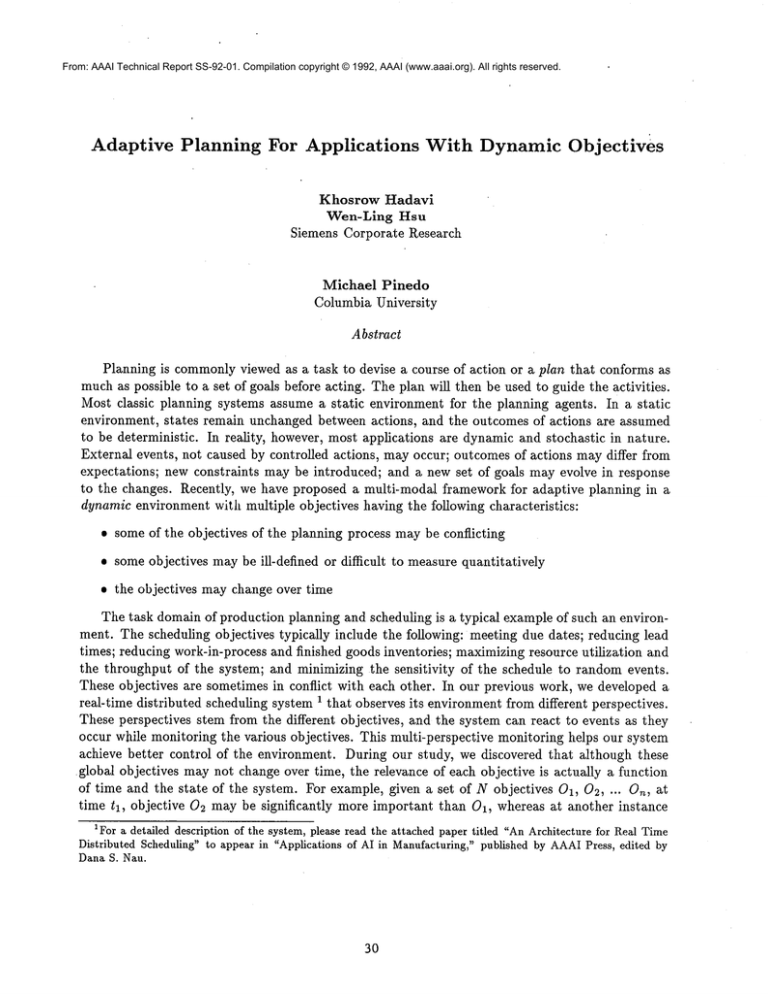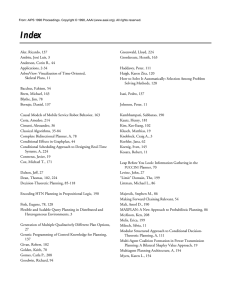
From: AAAI Technical Report SS-92-01. Compilation copyright © 1992, AAAI (www.aaai.org). All rights reserved.
Adaptive
Planning
For Applications
With Dynamic Objectives
Khosrow Hadavi
Wen-Ling Hsu
Siemens Corporate Research
Michael Pinedo
Columbia University
Abstract
Planning is commonlyviewed as a task to devise a course of action or a plan that conforms as
muchas possible to a set of goals before acting. The plan will then be used to guide the activities.
Most classic planning systems assume a static environment for the planning agents. In a static
environment, states remain unchanged between actions, and the outcomes of actions are assumed
to be deterministic. In reality, however, most applications are dynamic and stochastic in nature.
External events, not caused by controlled actions, may occur; outcomes of actions maydiffer from
expectations; new constraints may be introduced; and a new set of goals may evolve in response
to the changes. Recently, we have proposed a multi-modal framework for adaptive planning in a
dynamic environment with multiple objectives having the following characteristics:
¯ some of the objectives of the planning process maybe conflicting
¯ some objectives maybe ill-defined
or difficult
to measure quantitatively
¯ the objectives may change over time
The task domain of production planning and scheduling is a typical example of such an environment. The scheduling objectives typically include the following: meeting due dates; reducing lead
times; reducing work-in-process and finished goods inventories; maximizingresource utilization and
the throughput of the system; and minimizing the sensitivity of the schedule to random events.
These objectives are sometimes in conflict with each other. In our previous work, we developed a
real-time distributed scheduling system 1 that observes its environment from different perspectives.
These perspectives stem from the different objectives, and the system can react to events as they
occur while monitoring the various objectives. This multi-perspective monitoring helps our system
achieve better control of the environment. During our study, we discovered that although these
global objectives may not change over time, the relevance of each objective is actually a function
of time and the state of the system. For example, given a set of N objectives 01, 02, ... On, at
time tl, objective 02 may be significantly more important than 01, whereas at another instance
1 For a detailed descriptionof the system,please read the attached papertitled "AnArchitecturefor RealTime
Distributed Scheduling"to appear in "Applicationsof AI in Manufacturing,"publishedby AAAIPress, edited by
DanaS. Nau.
of time t2, objective 01 may becomemost important. Furthermore, each heuristic implies a set of
reactive strategies that move the system toward some objectives but away from other objectives
(due to the conflicting nature of these objectives).
In our current research, we devise a qualitative control layer to be integrated into a real-time
multi-agent reactive planner. The reactive planning system consists of distributed planning agents
attending to various perspectives of the task environment. Each perspective corresponds to an
objective. The set of objectives considered are sometimes in conflict with each other. Each agent
receives information about events as they occur, and a set of actions based on heuristics can be
taken by the agents. Within the qualitative control scheme, we use a set of qualitative feature
vectors to describe the effects of applying actions. A qualitative transition vector is used to denote
the qualitative distance between the current state and the target state. Given a target state and
a set of heuristics, we have an algorithm to test the reachability of the target state. Wewill then
apply on-line learning at the qualitative control level to achieve adaptive planning. Our goal is
to design a mechanismto refine the heuristics used by the reactive planner every time an action
is taken toward achieving the objectives, using feedback from the results of the actions. When
the outcome is compared with expectations, our prior objectives may be modified and a new set
of objectives (or a new assessment of the relative importance of the different objectives) can
introduced. Because we are able to obtain better estimates of the time-varying objectives, the
reactive strategies can be improved and better prediction can be achieved.





